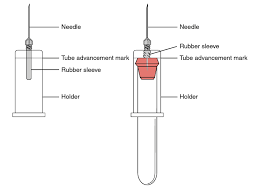Which of the following actions is required immediately after a phlebotomist experiences an accidental needlestick injury when drawing blood from a patient who has HIV?
Report the exposure to the supervisor.
Report the exposure to the CDC.
Send the patient for further STI testing.
Save the collection device for future evaluation.
The Correct Answer is A
Choice A reason:
Reporting the exposure to the supervisor is the immediate and required action after experiencing a needlestick injury. The supervisor will then guide the phlebotomist through the institution's post-exposure protocol, which includes immediate care of the wound, evaluation of the exposure, and initiation of post-exposure prophylaxis (PEP) if necessary. This step is crucial to ensure that the risk of HIV transmission is minimized and that the phlebotomist receives appropriate medical attention and follow-up.
Choice B reason:
Reporting the exposure to the Centers for Disease Control and Prevention (CDC) is not the immediate action required. The CDC provides guidelines and recommendations for handling such incidents, but the initial report and response are managed at the healthcare facility level. The CDC may be involved in the tracking of such incidents on a larger scale or providing statistical data, but they are not the first point of contact.
Choice C reason:
Sending the patient for further sexually transmitted infection (STI) testing is not an immediate action required following a needlestick injury. The patient's HIV status is already known, and the focus should be on the treatment and protection of the healthcare worker who experienced the needlestick. Any additional testing of the patient would be unrelated to the immediate management of the injury.
Choice D reason:
Saving the collection device for future evaluation is not a standard procedure. While the device may be retained as part of the incident investigation to determine how the injury occurred and to improve safety measures, the immediate concern is the treatment of the injured healthcare worker. The device itself does not play a role in the post-exposure management of the worker.
Nursing Test Bank
Naxlex Comprehensive Predictor Exams
Related Questions
Correct Answer is A
Explanation
Choice A reason:
The lateral section of the plantar heel is the recommended site for capillary blood collection in infants, particularly those under 6 months of age. This area is preferred because it is sufficiently vascularized for blood collection and poses less risk of injury to bones and nerves compared to other areas.
Choice B reason:
The central area of the heel is not recommended for capillary blood collection in infants due to the higher risk of injury to the calcaneus (heel bone) and potential for calcaneal osteomyelitis, an infection of the bone.
Choice C reason:
The posterior curvature of the heel is also not an appropriate site for capillary blood collection in infants. This area has a higher likelihood of causing pain and injury, as well as being less accessible for a proper puncture technique.
Choice D reason:
The palmer surface of the distal phalanx (fingertip) is not a recommended site for capillary blood collection in infants under 1 year of age. The fingertips of infants are small and more prone to injury, and the procedure may be more painful compared to a heel stick.
Correct Answer is A
Explanation
Choice A Reason:
The evacuated tube system is designed for the collection of multiple blood specimens using interchangeable tubes. This system utilizes a double-pointed needle, one end of which goes into the patient's vein and the other into a vacuum tube. As the blood is drawn, it automatically fills the tube until the vacuum is exhausted. The phlebotomist can then easily replace the filled tube with another without removing the needle from the patient's vein, allowing for multiple samples to be taken during a single venipuncture.
Choice B Reason:
The hypodermic needle and syringe system is typically used for manual blood draws when the evacuated tube system is not suitable, such as with small or fragile veins. This system does not use interchangeable tubes; instead, the blood is drawn into a syringe and then transferred into the appropriate tubes, which can be time-consuming and increase the risk of hemolysis or contamination.
Choice C Reason:
A winged infusion set, also known as a butterfly needle, is often used for patients with difficult veins. Like the hypodermic needle and syringe system, it does not inherently allow for the use of interchangeable multi-sample tubes. Blood is collected into a syringe or a single tube attached to the butterfly needle, and changing tubes usually requires a new puncture for each sample.
Choice D Reason:
The lancet microcollection system is used for capillary blood collection, typically from a fingerstick or heelstick. It is used for small volume samples and does not accommodate interchangeable multi-sample tubes. This method is commonly used for pediatric patients or when only a small amount of blood is needed.

Whether you are a student looking to ace your exams or a practicing nurse seeking to enhance your expertise , our nursing education contents will empower you with the confidence and competence to make a difference in the lives of patients and become a respected leader in the healthcare field.
Visit Naxlex, invest in your future and unlock endless possibilities with our unparalleled nursing education contents today
Report Wrong Answer on the Current Question
Do you disagree with the answer? If yes, what is your expected answer? Explain.
Kindly be descriptive with the issue you are facing.
